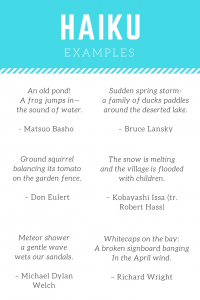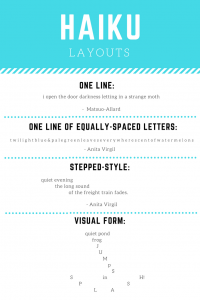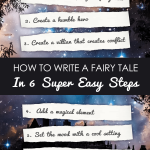How to Write a Haiku Poem Plus 6 Tips & Examples
Most people think writing a Haiku is easy, but a really good haiku takes time and practice. In this guide we’ll show you how to write a Haiku poem with some expert tips.
The earliest example of a short haiku dates back to the sixteenth-century and since then there have been a ton of haiku poets, including Matsuo Basho, Anselm Hollo and Kobayashi Issa. For anyone who doesn’t know what a haiku is, it is a three-lined poem that normally has 17 syllables written in a 5/7/5 syllable count. Typical Haikus are about animals, seasons and anything else relating to nature. To celebrate and honour the art of haiku writing, April 17th is Haiku Poetry Day. This is the perfect opportunity to write your first ever haiku and master of the art of haiku writing. And to help you out, here are 6 tips to write your first ever haiku.
6 Tips for writing your first ever haiku:
Tip 1: Before writing your haiku, read others
When it comes to writing in general, it is always good to read the work of others. This not only inspires you but also gives you an idea of what good writing looks like and what brilliant writing looks like. And even though you might think that haiku poems are simple and easy, they’re really not! A good haiku creates an image in your head and ends with a surprise to keep the reader engaged. Also, remember not to rush and have a break between each haiku, so you can really enjoy each one!

Here are a couple of haiku examples from famous poets. We also recommend borrowing books from your library to find more examples!
Tip 2: Writing your first sentence
The first line of your haiku is the most crucial. Starting your haiku strong will help you finish strong. Most haiku poems start with a description of a season or natural setting. Then in the rest of the poem you can continue to use words related to that first sentence. Take a look at the poem by Matsuo Basho below, see how it starts:
An old pond!
A frog jumps in—
the sound of water.
– Matsuo Basho
Tip 3: How to structure your haiku
There are a number of ways you can structure your haiku. Here are some simple haiku techniques for beginners to try out:
- Contrast: A contrasting structure is about thinking about opposites in nature, such as a big thing and a small thing or something loud and something quiet. In the example below, the hard rain is the opposite of the tender new leaves:
Long hard rain
Hanging in the willows
Tender new leaves.
– Jane Reichhold
- When, Where and What: This technique is probably the most easiest. Simply start by describing the when (season, time etc.), then the where is the location (on a beach, top of a mountain etc.) and finally what is happening (birds sing, snow fall etc.). You can rearrange the order of this to suit your haiku. Here’s an example:
Where: Whitecaps on the bay:
What: A broken signboard banging
When: In the April wind.
– Richard Wright
- Narrowing Focus: Here you start the Haiku on something wide or general and then narrow it down to the details. Take a look at the example below:
A buzzing city
Townhouses lined up
The sound of chatter.
- Comparison Comparison haiku make use of metaphors or similes. They include two different images that are in some way similar to each other. Take a look the comparison below between people scattered like scattered leaves:
People scattered
the leaves too scattered
and spread.
Tip 4: Get visual with your words
Good haiku have good images. This means being able to describe everyday objects in detail. For example a yellow tulip blooming or a blue car speeding. Once you have a list of descriptive words, you can add them together into a Haiku of your own. A haiku in general can have one, two or even three different descriptive images. Take a look at the descriptive images in the haiku below:
The crow has flown away:
swaying in the evening sun,
a leafless tree.
– Natsume Soseki
Tip 5: Experiment with different haiku layouts
Even though the most common haiku follow a three line layout. There are many poets who write their haiku onto one line or in a stepped-style (see some of the examples below).
Tip 6: Keep practising
Keep reading and keep having fun when writing your own haiku poems. The most important thing is that you are having fun and writing about things you love. Once you are comfortable with writing your own haiku poems, you can even set yourself a challenge to write one haiku a day. Then a year later you will have your own collection of over 300 haiku poems to read! And as a bonus, you can even keep your collection of haiku poems in a journal or create your own mini notebook, using our mini paper notebook tutorial.
Share your haiku poems with us!
Now you know how to write your first ever haiku, it’s time to get writing. We would love to read your haiku poems, so please do share them with us in the comments. In the meantime, why not try writing a clerihew poem or reading some poetry examples from the Story Saturday community to inspire you.







Comments loading...